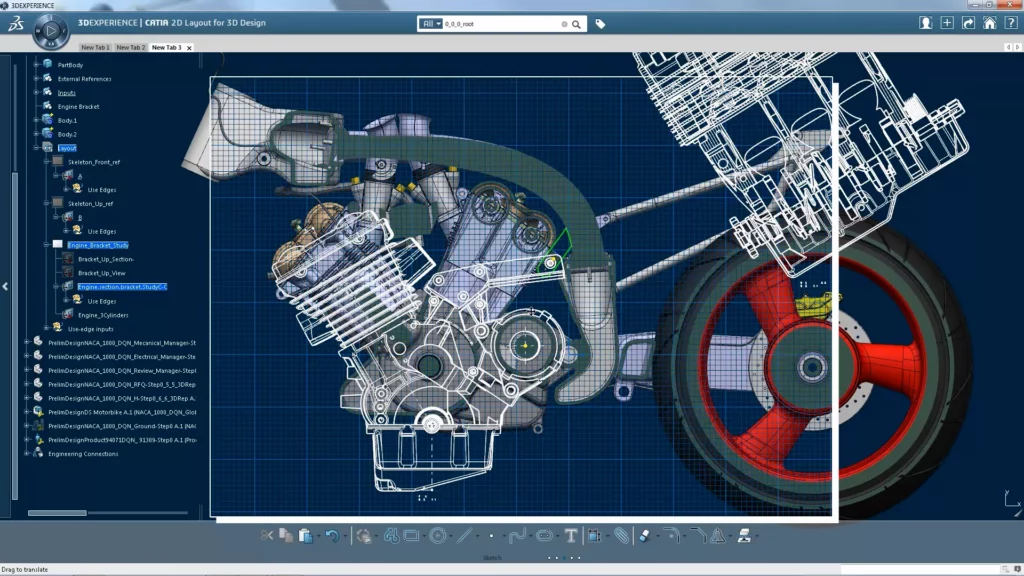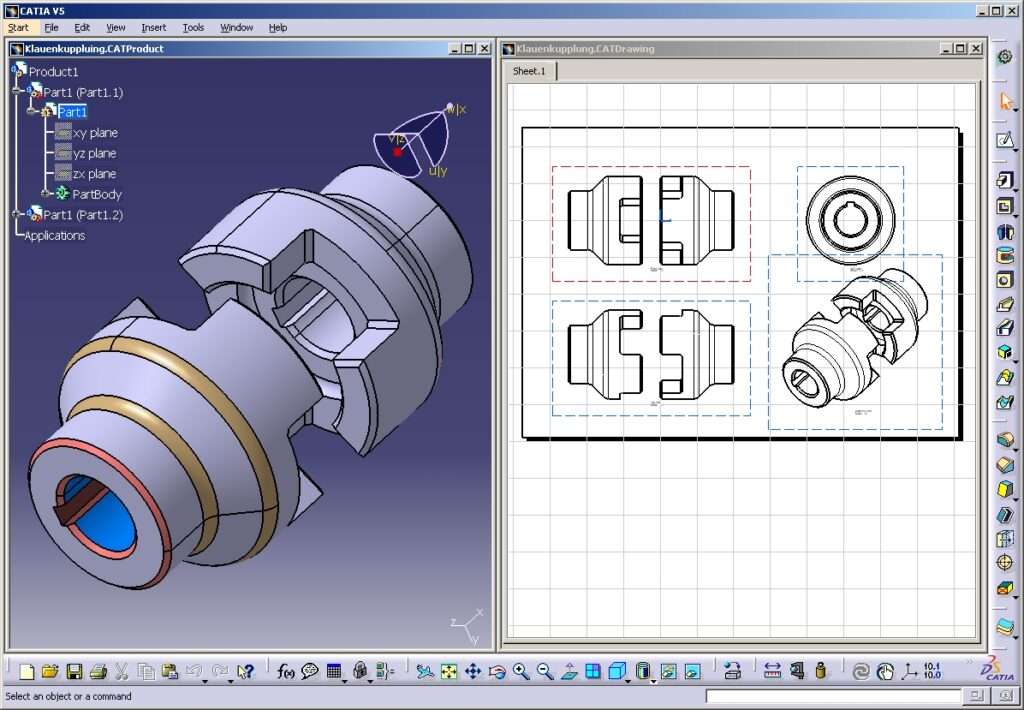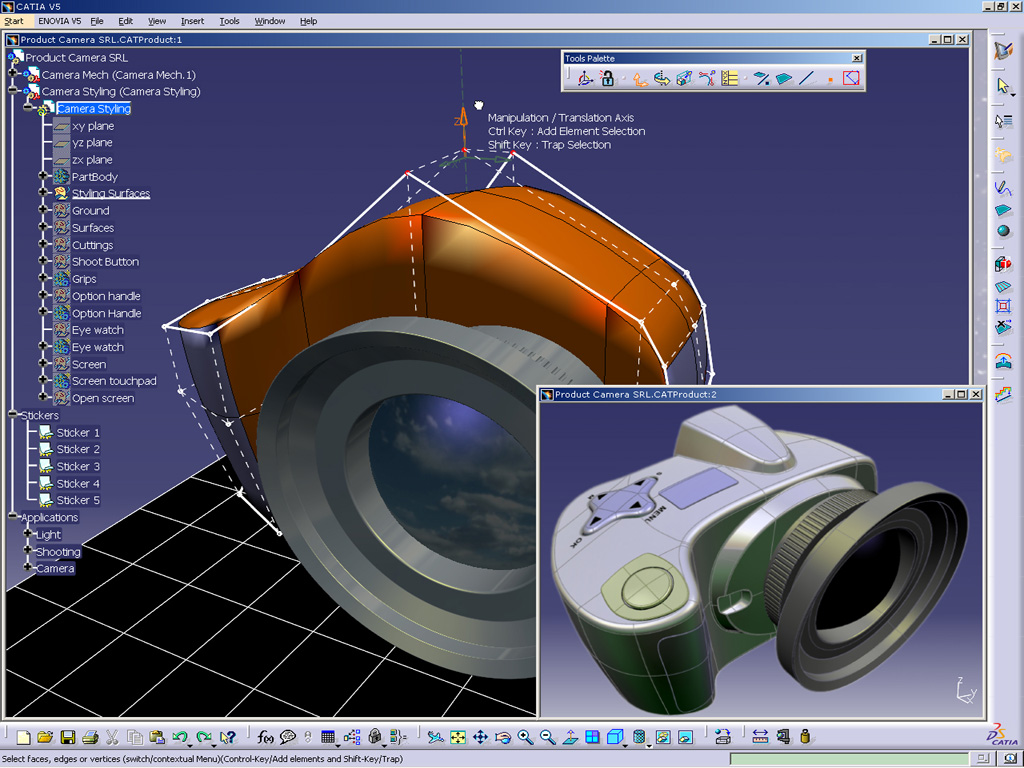Creating innovative products that stand out in the market can be a challenging task for designers and engineers. CATIA software, a leading design software, offers comprehensive tools to transform your ideas into reality.
This blog post will delve into CATIA’s myriad capabilities, demonstrating how its versatile features facilitate exceptional product development and design from concept to completion.
Keep reading to uncover how CATIA software can revolutionize your creative process.
Key Takeaways
- CATIA software stands for Computer-Aided Three-Dimensional Interactive Application, a versatile tool used in various industries to turn 2D sketches into complex 3D models.
- The software has evolved since its beginnings in aircraft design with Dassault Systems in 1977, now offering advanced versions like CATIA V5 and 3DEXPERIENCE for comprehensive product lifecycle management.
- Key functionalities of CATIA software include part modeling, assembly modeling, surface modeling, finite element analysis (FEA), sheetmetal part design, rendering, and engineering drawing creation.
- Generative Design within CATIA allows for the optimization of products through computational design and parametric modeling leading to innovative solutions such as those pursued by Interstellar Lab.
- Through a suite of CAD/CAM/CAE tools interlinked with systems engineering processes and PLM integration like ENOVIA, CATIA software is essential for efficient mechanical design and plays a crucial role across all stages of product development.
Understanding CATIA: Multi-Platform Software Suite for Product Design and Development
CATIA software is a powerful software used for computer-aided design and engineering and manufacturing developed by Dassault Systèmes. It offers a wide range of functionalities such as part modeling, assembly modeling, surface modeling, finite element analysis, and more to support the product development process.
The history and current version of CATIA demonstrate its evolution into an essential tool for designers and engineers.
Definition and Purpose of CATIA Software
CATIA software stands for Computer-Aided Three-Dimensional Interactive Application, a powerful tool used by engineers and designers across various industries such as aerospace engineering and automotive design.
It enables users to create complex models from simple 2D sketches, turning them into highly detailed 3D structures. This software plays a critical role in product lifecycle management, streamlining the process from initial concept to final product.
The purpose of CATIA solution goes beyond just modeling; it’s designed to foster virtual collaboration among teams. Engineers can work together on designs in real-time, no matter where they are located, allowing for seamless integration of engineering solutions.
With immersive user experiences and support services that ensure software certification and reliable functionality, CATIA software is central to transforming ideas into tangible products with efficient design processes.
Check more ALLDATA Reviews – OEM Automotive Repair Information

(Image Credit: goengineer)
History and Current Version of CATIA software
The journey of CATIA began as an in-house development by the French aircraft manufacturer Avions Marcel Dassault, back in 1977. It was initially created to provide 3D modeling capabilities that were revolutionary at the time for its aircraft designs.
Since then, it has expanded vastly and become a core product lifecycle management (PLM) software used by various industries, including aerospace, automotive, and industrial design.
Over the years, CATIA has evolved through different versions with significant enhancements to cater to the complex needs of virtual prototyping.
Today’s users work with several advanced versions like 3DEXPERIENCE CATIA and proficient tools such as CATIA Magic along with the well-known CATIA version 5. These current incarnations offer digital mockup functionalities integrated within a modern system engineering approach.
Companies leverage these tools to streamline their design processes and boost innovation while staying connected with user communities for support and collaboration—the power drivers behind this robust engineering software’s ongoing success story.
Key Functionalities of CATIA Software
CATIA software offers a range of key functionalities, including part modeling, assembly modeling, finite element analysis, and rendering. These tools allow for the creation of complex 3D models and simulations to support product development and design processes.
Part Modeling
Creating complex 3D parts has never been easier with CATIA software’s part modeling workbench. Here, designers transform their creative concepts into solid models using parametric and direct modeling techniques tailored to the needs of industries such as automotive, aerospace, and consumer goods.
These tools allow for precise control over every detail in the product design process, enhancing innovation while ensuring manufacturability.
Users find that working within this aspect of CAD software unveils a multitude of functionalities. The system enables them to sketch profiles, create pads and pockets, and craft intricate features necessary for mechanical components.
This level of versatility ensures that whether an engineer is focused on small gadgets or large machinery components, they can model parts effectively within CATIA V5 or its more advanced versions like CATIA V6 and 3DEXPERIENCE platform.
Assembly Modeling
CATIA software’s Assembly Modeling workbench enables the creation and management of complex assemblies and subassemblies with ease. This functionality allows for visualizing components, managing assembly structures, and applying constraints to ensure proper interaction between parts.
This engineering software also provides tools for simulating and validating assembly processes and motion, contributing to efficient design validation processes.
Integration with PLM products like ENOVIA offers seamless collaboration and data management within the Assembly Modeling process. CATIA 3DEXPERIENCE extends its capabilities by providing a web-based platform for connecting various areas of an organization beyond engineering.
With these functionalities, CATIA software proves instrumental in streamlining the creation and management of intricate assemblies during product development.
Surface Modeling
Surface modeling is a fundamental function within CATIA software, playing a crucial role in constructing and designing various products. Engineers and designers utilize surface modeling for applications such as design and styling, electrical systems, fluid systems, engineering, and even for creating sustainable living solutions on Earth and beyond.
These capabilities are integrated into CATIA 3DEXPERIENCE-based industry solutions for model-based systems engineering, enterprise architecture, concept modeling, and ontologies. The incorporation of surface modeling across CATIA V5, V6, and CATIA 3DEXPERIENCE underscores its significance in CAD/CAM/CAE processes and emphasizes its central role in industrial design.
CATIA’s surface modeling fosters innovation by allowing engineers to create complex surfaces with precision while also enabling the generation of aesthetically pleasing designs that meet functional requirements.
Finite Element Analysis
CATIA software offers powerful Finite Element Analysis (FEA) capabilities, allowing engineers to simulate and analyze the behavior of designs under various conditions. Using FEA, mechanical engineers can assess stress distribution, deformation, and performance of components or assemblies to ensure structural integrity.
This enables accurate prediction of how products will behave in real-world scenarios, ultimately leading to more robust and reliable designs. Additionally, CATIA’s seamless integration with FEA empowers designers and engineers to optimize product performance while reducing material usage and production costs.
Engineers benefit from CATIA’s FEA by gaining insights into the structural response of their designs before physical prototyping begins. Through this process, they can refine their models iteratively, resulting in improved product quality and durability while reducing time-to-market.
Sheetmetal Part Design
CATIA software offers Generative Sheetmetal Design, allowing for the creation of associative feature-based models for sheet metal parts. This functionality facilitates concurrent engineering by supporting the design process of sheet metal components within an assembly, ensuring seamless integration and collaboration across teams.
With CATIA’s dedicated workbench for Generative Drafting, users can efficiently translate 3D part and assembly definitions into detailed drawings, streamlining the production and fabrication of sheet metal components.
The software’s support for feature-based design empowers users to create complex sheet metal structures with ease while maintaining associativity between parts and assemblies. By leveraging this capability, manufacturers can optimize their processes and enhance productivity in various stages of product development – from initial design to final production.
Rendering
CATIA’s rendering functionality allows users to create realistic and high-quality visualizations of their 3D models. It enables the addition of textures, lighting effects, and shadowing to enhance the appearance of the design.
Furthermore, CATIA’s rendering capabilities provide an opportunity to present product concepts in a compelling and visually appealing manner, aiding in effective communication with stakeholders and clients.
Incorporating rendering into the design process facilitates better decision-making by allowing designers to evaluate various aesthetic options before finalizing a product concept. The integration of rendering with other CATIA software functionalities streamlines the workflow, ensuring that designs are not only visually stunning but also technically accurate.
Engineering Drawing creation
CATIA software offers a dedicated workbench for Engineering Drawing creation, allowing engineers and designers to produce precise technical drawings with ease. This functionality is crucial for translating 3D models into detailed plans that guide manufacturing processes and ensure product quality.
CATIA V5, V6, and CATIA 3DEXPERIENCE are widely used versions that provide comprehensive tools for drafting, technical drawing, and adherence to drafting standards. As a result, companies like Interstellar Lab rely on CATIA’s capabilities for creating sustainable life solutions on Earth and beyond.
With CATIA’s robust Drafting module, users can seamlessly generate assembly drawings using geometric dimensioning and tolerancing principles while adhering to industry standards. Whether it’s designing intricate components or complex mechanical systems, the Engineering Drawing creation feature in CATIA empowers professionals to communicate design intent accurately throughout the product development cycle.

(Image Credit: Wikipedia)
Use CATIA Software in Product Development and Design
From 3D modeling and CAD/CAM to mechanical design and simulation, CATIA software plays a crucial role in every stage of product development. Are you ready to explore the countless possibilities that CATIA software offers for your next project?
3D Modeling
CATIA’s 3D modeling capabilities play a pivotal role in product development and design. Through parametric modeling tools, users can create precise and intricate three-dimensional representations of parts and assemblies.
This feature is vital for digital prototyping and product visualization, allowing engineers to refine designs with accuracy and efficiency.
Moreover, CATIA’s 3D modeling functionality enables seamless integration with other aspects of the product lifecycle management process, such as engineering drawing creation and rendering.
CAD / CAM
CATIA software plays a pivotal role in product development and design through its CAD/CAM capabilities. It empowers engineers to seamlessly transition from computer-aided design (CAD) to computer-aided manufacturing (CAM).
As an integral aspect of the product lifecycle, CATIA’s sophisticated CAD functions ensure precise modeling, prototyping, and visualization of products. Its seamless integration with CAM then allows for the efficient translation of digital designs into physical prototypes and end-products.
With CATIA software as a part of the workflow, engineers can harness advanced precision engineering tools that streamline the entire process – from initial concepts to final production. This enables rapid iterations and adjustments based on real-time feedback, ultimately leading to faster time-to-market and heightened competitiveness in today’s fast-paced innovation landscape.
Check more Mastering 3D Design with Tinkercad: A Beginner’s Guide to Online CAD Modeling

(Image Credit: Wikipedia)
Generative Design
Generative design empowers engineers and designers to explore innovative solutions, pushing the boundaries of traditional product development. With CATIA’s advanced engineering capabilities, generative design enables conceptual modeling and model-based systems engineering to optimize designs for cutting-edge technology.
This approach leverages computational design and parametric modeling, resulting in design optimization that paves the way for groundbreaking products.
Leading companies like Interstellar Lab use CATIA’s generative design tools to harness the power of engineering solutions, showcasing how this feature plays a pivotal role in shaping the future of product development.
Mechanical Design
CATIA software encompasses a wide array of mechanical design disciplines, covering everything from part modeling to finite element analysis. It plays a crucial role in 3D modeling, CAD/CAM, and simulation & analysis for product development and design.
With its integration of CAD, CAE, and CAM functionalities, CATIA software provides an essential framework for efficient mechanical engineering within the product lifecycle management process.
The software’s offerings encompass not only traditional mechanical design but also extend to generative design and virtual prototyping. Its capabilities enable industrial designers to create highly detailed 3D models that facilitate the optimization of designs while providing accurate rendering visuals for enhanced visualization during the production stage.
Simulation & Analysis
Transitioning from mechanical design to simulation and analysis, CATIA software plays a vital role in validating designs with its robust simulation and analysis capabilities. It offers comprehensive engineering tools for virtual prototyping and digital simulation, enabling engineers to perform product modeling and design validation efficiently.
CATIA software provides the necessary resources for engineering analysis, ensuring that every aspect of the design is thoroughly evaluated before moving into physical production.
Additionally, CATIA incorporates finite element analysis tools that allow engineers to conduct virtual testing, making it an indispensable asset in the product development process.
Systems Engineering
Transitioning from the in-depth analysis of simulation and analysis, we delve into the vital role of systems engineering within CATIA software. Systems engineering encompasses a holistic approach to product development, integrating various disciplines and engineering collaboration for efficient product lifecycle management.
CATIA offers a comprehensive suite of tools that streamline systems integration, enabling digital engineering and model-based engineering solutions essential for modern design processes.
CATIA software plays a pivotal role in fostering cross-functional collaboration across different areas of an organization beyond traditional engineering realms. It facilitates seamless integration with PLM products like ENOVIA, connecting diverse teams involved in product design and development.

Conclusion
Exploring the Versatility of CATIA software for Product Development and Design reveals a powerhouse of tools for engineers, architects, and designers. Its broad capabilities cover construction, design, electrical & fluid systems, engineering, and even sustainable life solutions on Earth and beyond.
With user communities and resources like blogs and e-seminars alongside Facebook and Twitter connections – CATIA software is not just software; it’s a thriving ecosystem supporting innovation in product development and design.
Whether you’re a student, an academic professional or part of a company – the availability of courses ensures everyone can harness the power of CATIA efficiently.
Frequently Asked Questions
What is CATIA software used for in product development and design?
CATIA is used to create 3D models, perform simulations, analyze designs, and generate technical documentation for various products.
How does CATIA software contribute to streamlining the product development process?
CATIA software facilitates collaborative work among design teams and enables efficient visualization of concepts, leading to faster iterations and reduced time-to-market.
Can CATIA be integrated with other software commonly used in product development?
Yes, CATIA can be integrated with various CAD/CAM/CAE systems as well as enterprise solutions for effective data exchange and interoperability.
What are the practical advantages of utilizing CATIA’s surfacing capabilities in design?
Utilizing CATIA’s surfacing capabilities allows for creating complex shapes, ergonomic designs, and aesthetically appealing product surfaces with precision and efficiency.
How does understanding CATIA software benefit professionals involved in industrial or mechanical design?
Understanding CATIA software equips professionals with advanced tools to optimize designs, reduce errors during manufacturing stages, improve overall quality control processes, and achieve innovative outcomes.



